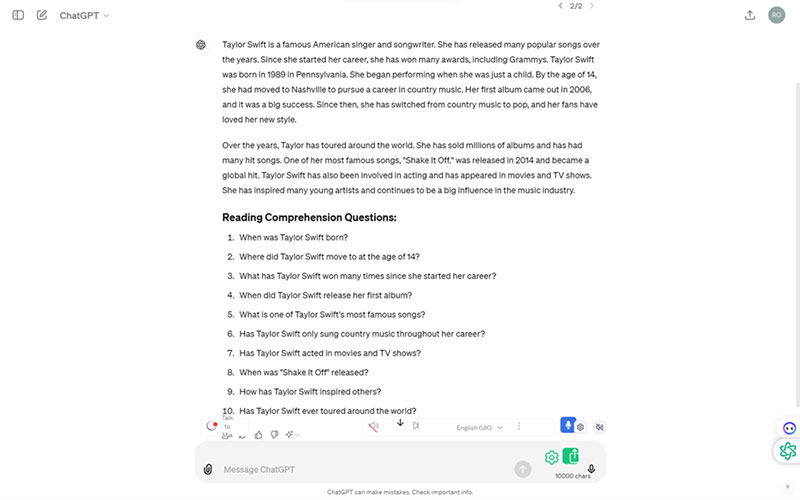28th June 2024
Creating engaging and effective worksheets is a time-consuming process. Even if you download worksheets from a website, the process of searching for something suitable can be as onerous as making your own. In this blog post, we'll look at a different solution: using AI to generate worksheets. As well as saving you time, AI can add interesting twists to traditional worksheets. With AI assistance, you can personalise, target and differentiate your worksheets. In this post we’ll cover:
- adapting worksheets to students’ interests and ability levels.
- generating new worksheets based on existing templates.
- changing the linguistic focus of worksheets.
- creating different types of worksheets, such as wordsearches, crosswords and gap fills.
- using these materials effectively.
Personalising materials
One of the big challenges with off-the-shelf materials is irrelevance. Students get drilled with phrases they never use, learn to talk about foods they’ve never tasted and read about topics they’re not interested in. AI can change this.
Let’s imagine that you’re teaching a group of elementary students a unit about music. The grammar in the unit is the past simple and present perfect. You want to give the learners something to read after class. You need a text with examples of the grammar. What bands do you choose for the students to read about? If I was your student and you asked me to read about Taylor Swift or Bruno Mars, I probably wouldn’t do your homework. But if you gave me a reading about Robert Johnson, the Band or REM, I’d probably read it at over and over.
To create personalised texts, you’ll need an example passage and questions. You might write these yourself, or take them from a coursebook or an existing worksheet. Then, ask AI to create new worksheets about your students’ favorite bands.
Prompt: Look at the worksheet for English language students. Create new worksheets in the same style also practicing [grammar or vocabulary]. Each worksheet should be able one of the following bands. Bands: ### [List of bands]. ### Worksheet: ### [worksheet].

Taylor Swift themed reading using ChatGPT
This generates new worksheets which match my students’ favorite bands. As well as generating higher levels of engagement, these texts will be easier for learners to understand. Students’ background knowledge will make comprehension easier.

More music themed worksheets from Chat GPT.
Differentiating Materials
You might inwardly groan when you hear the word “differentiation”. Perhaps on a DipTESOL or DELTA course, you created versions of worksheets at multiple different levels. Great idea in theory. But in practice, who has that much time? With AI, we all do. AI can quickly generate simpler (or harder) versions of existing materials for learners of different levels. This can allow everyone in a class to be challenged at the right level.
We can create a new version of our music worksheet (above) by giving this to an AI and asking it to simplify aspects of the text.
Prompt: Create an easier version of this worksheet, but keep the topic the same. Simplify the vocabulary and make the sentences shorter. Worksheet: ### [Original worksheet]

Simplified REM worksheet from ChatGPT
A word about how to use these in class. You could decide for yourself which students should get which worksheets. This subtly lets everyone read something at the right level without drawing attention to the different abilities in the class. An alternative is to let the learners decide. Place the two (or more) versions of the worksheet on your table and say, “Choose one of these. The one on the left is a little easier. The one on the right is a little harder. If you want my advice on which to choose, ask me.” After students finish the activity, ask, “Did you choose the right worksheet? Was it too easy, too hard or just right?” This reflection helps learners make a more informed choices in the future.
Mimicking Existing Worksheets
Let’s say that your school already has a bank of materials that you use with your students. Maybe these are great, but you’ve run out. Or perhaps the topics don’t match your students’ interests. Creating your own can take hours. With AI, creating a new worksheet takes seconds.
In the next example, I’ve uploaded a reading worksheet with a short text, true or false questions, and a vocabulary exercise. I’ve asked ChatGPT to change the topic of the worksheet. I could also personalise or differentiate the worksheet using the techniques described above.
Prompt: Create a new version of this worksheet on the topic of [topic].

Football worksheet from ChatGPT
As well as creating new worksheets on different topics, AI can also adapt existing materials for new language points. Let’s take one of the worksheets above, on the topic of music with a focus on the past simple vs present perfect. We can take this worksheet and ask AI to adapt it for a different grammar point, such as passive voice (below).
Prompt: Change the focus of this worksheet to [new language point]. Keep the topic and most of the vocabulary the same. Worksheet: ### [original worksheet].

Robert Johnson passive voice worksheet with Gemini
Although this can seconds, the results aren’t always spot in. Funny things can happen when you ask AI to use specific grammar on certain topics. Read whatever the AI produces before giving it to your students to make sure that the language is and sounds natural.
Crosswords
AI, at the moment, doesn’t seem to be good at designing crosswords. But fear not! There are a bunch of free websites that are great at crossword design (like Crossword Puzzle Maker).
What AI is good at, is creating clues for crosswords. Let’s say that we’re teaching a business English class. We want to make a crossword to review vocabulary from last week’s lesson. We can take our vocabulary list and ask AI to create a gap fill for these words.
Prompt: Create a gap fill EFL activity for business English students using the following words: ### [your words]. ### Use simple English. These will be used as clues in a crossword.
We then get the following clues from AI.

Crossword clues from Claude
These can then be copied and pasted into a crossword maker (such as Crossword Puzzle Maker) and used as a review activity at the beginning of class.

Crossword with clues from Claude and design from Crossword Puzzle Maker
Matching activities
Matching activities are a quick way to check learners have understood new vocabulary. There are several different kinds of matching activity, depending on the language your students are working on. AI can help create many of these.
One exciting option is to use an AI art generator to create an image. Learners can label the image using vocabulary from a previous class. Giving AI a list of vocabulary doesn’t necessarily result in a cohesive image. Instead, try creating a general image. Then delete parts of the image and tell AI what to add. (The image below was created by generating a living room, then adding the cat, the bookshelf and a lamp.)

Picture for a matching activity with a living room (to practice, chair, sofa, plant, table, lamp, books pictures and cat) from Adobe Firefly.
We can similarly ask AI to create matching activities for words and definitions or synonyms.
Prompt: Create a matching activity for [CEFR level] EFL learners. Learners need to match a word on the left side of the sheet with a simpler [definition or synonym] on the right. Words: mittens, cap, sandals, cardigan, tank top, vest, polo neck.

Simple clothes matching activity with Gemini
Rearranging Sentences
A common way of practicing new grammar or sentence structures is to create jumbled sentences. These include all the same words as regular sentences, but mixed up. By putting these back in the right order, students apply their knowledge about grammar. A typical example might look like the one below.

Passive voice practice from ChatGPT
AI can create example sentences and change the order of the words, like the one above, but this isn’t a big time-saver. However, AI can make these activities more meaningful by:
- creating images to go with the jumbled sentences, making the meaning clearer.
- suggesting extensions for learners after they have completed the worksheet. (Unless you are teaching a one-to-one class, some learners always finish faster than others, making extensions useful.)
- writing sentences which relate to a theme, topic or are all part of the same conversation (example below).
Prompt: Write a [number] line dialogue. Person A should use the [grammar]. Person B can ask questions. Present what person A says as jumbled sentences, with the words out of order. This should be on the topic of [topic].

Contextualised passive voice practice from ChatGPT
Gap Fills
Gap fills are a quick and simple way of helping learners use new language in a controlled setting. This kind of activity often elicits groans from students (and teacher trainers). Although gap fills are easy to make, good gap fills are not. Below are ways to make gap fills more interesting and productive:
- Make it more natural. Instead of fill in the blank, ask learners to replace a word or phrase with something they learned today to make an example more natural.
- Order the sentences. After filling in the gaps, learners can put the sentences in order so they form a coherent text. There can be more than one right answer to the ordering, adding to the cognitive engagement.
- Ambiguity. Create gap fills with more than one right answer. This is likely to create more discussion and deeper thinking in learners than a worksheet where only one answer is possible.
- Opinions please. After completing a gap fill in a conversation, email or speech, students can be asked to give their opinion about the completed text. They could decide which speaker in the conversation they agree with, write a reply to the email or think of a follow up question to ask the person giving a speech.
- Review and replace. Ask students to look at a dialogue which includes the target language. Tell them to replace the target language with words or phrases that they already know. This should show you if the learners understand the meaning of whatever they’ve just learned.
- Add context. Instead of filling in blanks in unrelated sentences, create gaps in a conversation, email or speech. This makes it easier to understand what’s going on and why the speakers are using the target language (AI generated example below).
- Move the gap. After filling in the blank, learners can delete the first or second part of the sentence and fill this gap. This allows for more creativity as learners explore what comes after (or before) the target language.
- Anti-gap fill. Instead of filling in blanks with the new language, give learners new language with blanks on either side. Ask them to fill in these gaps instead.
Prompt: Create a [type of discourse, e.g. dialogue] gap fill for B1 level learners using the following phrases: ### [your phrases] ### Create two versions – one which includes blanks and one with the answers completed.

Contextualised gap fill from Gemini
Wordsearches
No blog post about worksheets would be complete without mentioning wordsearches. Although you might raise an eyebrow, wordsearches have several benefits for children learning to read. They help with word recognition, associate vocabulary with a lexical set, and reinforce spelling (especially if your wordsearch uses lower case letters rather than capitals). Wordsearches are simple to make with AI.
Prompt: Create a wordsearch about [blank] in a table format.
Alternative Prompt: Create a wordsearch in a table format containing the following words: ### [word list] ### Make this challenging my including words vertically, diagonally and horizontally.

AI wordsearch for teachers from ChatGPT
Your AI may create a wordsearch using VBA script. To get this into a more user-friendly format:
- Open a Word document.
- Press Alt + F11 to open the VBA editor.
- Insert a new module (Insert > Module).
- Copy and paste the script into the module.
- Close the VBA editor.
- Press Alt + F8 to open the "Macro" dialog.
- Select CreateWordSearch, and click "Run".
This will create the word search grid and list the words to find in your Word document.
Making the Most of Worksheets
The types of worksheets described above are probably more common in language classes than they are effective. At their worst, worksheets can be boring, passive and repetitive, decontextualised. Worksheets also put strain on teachers, requiring excessive grading. If you are going to create and use worksheets, consider integrating some of the suggestions below. These should integrate creativity, allow for mixed abilities and encourage self-expression.
- Include extension activities. Some students finish faster than others. Extensions give fast finishers something to do while they’re waiting on slower classmates to finish.
- Make your own. After learners finish a worksheet, challenge them to create a new version for their classmates. Children usually enjoy trying to catch out their classmates by asking tricky questions. Writing tricky questions involves deeper thinking, which in turn leads to learning.
- Personalise. Learners to personalise the language practiced in the worksheet. Using language to talk about ourselves helps us remember it better. After unscrambling a sentence, learners change each sentence so it applies to themselves.
- Peer check. Get learners to check the answers with a peer before discussing answers as a class. This can help students clarify their thinking and become more confident in sharing their answers with the class.
- Ask “Why?” When checking answers, ask students why a particular answer is correct. The point of worksheets isn’t successfully answering questions, but gaining a better understanding of a grammar rule or being more confident about how to use a word or phrase. More important than the right answer is the explanation.
Limitations
Let’s now look at some of the limitations of using AI to create worksheets for class.
Firstly, let’s talk about worksheets in general. Worksheets can be a valuable tool for review, variety or accuracy practice. But overusing them can lead to disengaged students. Balance using worksheets (AI generated or otherwise) with activities that promote active learning, communication, and thinking.
Now, let’s talk about using AI to create worksheets. AI-generated content can sometimes lack nuance. AI generated content isn’t always factually accurate. This is especially true for complex or unusual topics. Remember to review and edit any materials generated by AI before putting them in front of your students.
Similarly, the formatting of AI-generated activities may not always be perfect. These might require manual editing before you can hit ‘print’. Using multiple AI tools can sometimes help achieve better results.
Finally, we need to mention copyright. Occasionally, AI text generators don’t generate, they just regurgitate. This could lead to you accidentally violating the intellectual property rights of the original creators. Some authors may even think using their work as a basis for creating a new worksheet is unethical. Disclose the use of AI-generated content or paraphrase longer AI-generated passages.
Conclusions
In this post, we’ve explored how AI can quickly create high-quality worksheets tailored to your students' needs and interests. We discussed personalizing materials, differentiating content, and mimicking existing worksheets. As well as saving you time, this can result in greater engagement and learning. Although AI offers these benefits, we need to be mindful of its limitations. These include potential copyright issues and the need for careful review of content. However much or little you use worksheets, adding AI into the mix can create better content which can lead to more learning. To put some of these techniques into practice, join my next webinar on this topic.
Online Workshop - Creating Classroom Materials with AI - Wednesday, 3 July



